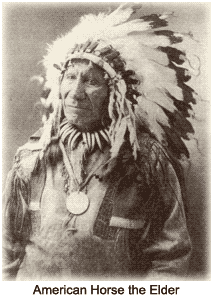 American Horse the Elder, also known as Washicun Tashanka, was the son of Old Smoke. He was born in 1800 into the Oglala Lakota (Sioux) tribe. He was a cousin of the Oglala chief Red Cloud. As a Lakota principal chief, he served with Chiefs Crazy Horse, Sitting Bull , and others, during the Plains Indian War.
American Horse opposed the white settlement of Lakota land nearly his entire life. During the Bozeman Trail War of the 1860s, also known as Red Cloud’s War, American Horse rode with Red Cloud. Even after the Fort Laramie Treaty of 1868 with its short-lived peace agreement, American Horse continued to oppose the white settlers.
In 1870, in the hope of persuading the government to uphold the Fort Laramie Treaty, American Horse accompanied Red Cloud to Washington, D.C. The treaty existed only until 1874, when gold was found in the Black Hills of what would become South Dakota. Miners, settlers, and speculators began once again to overrun sacred Lakota land.
Victory, then disaster
American Horse served as a principal military leader at the Battle of the Little Big Horn. Following their decisive victory over George A Custer and his 7th Cavalry in June 1876, the Lakota war parties split up, each doing what they thought best for their own safety.
Crazy Horse's band headed for the Little Bighorn Mountains, while Chief Sitting Bull and his people headed for Canada. A third group of 40 lodges (Indian family groups) commanded by American Horse, decided to go to an agency (reservation) assigned by the United States. As they traveled to the agency, American Horse's band crossed paths with troops commanded by General George Crook and Captain Anson Mills, at Slim Buttes.
Without warning, Crook ordered his men to attack the Lakota despite the fact the natives were proceeding peacefully across land guaranteed to them by treaty. A few escaped to join Sitting Bull's camp, but many in American Horse's band died. Near the end of the fight, American Horse, four warriors, and 15 women backed into a cave, but five remaining warriors refused to surrender.
A mortal wound
During the shooting, American Horse was mortally wounded by a shot through his abdomen. He writhed in excruciating pain as army surgeons struggled to save his life, but the wounded man refused their help.
Chiefs Sitting Bull and Gall mustered a rescue party to secure American Horse’s release, but did not reach him before he died at the age of 76. Following his death, cavalry soldiers scalped him.
Following the massacre, Sitting Bull visited the site and was sickened by the sight of the bodies of slaughtered women and children. American Horse died as he had lived, free and fighting to secure his homeland from invaders. That and other defeats led to a Lakota surrender in 1877.
American Horse the Elder, also known as Washicun Tashanka, was the son of Old Smoke. He was born in 1800 into the Oglala Lakota (Sioux) tribe. He was a cousin of the Oglala chief Red Cloud. As a Lakota principal chief, he served with Chiefs Crazy Horse, Sitting Bull , and others, during the Plains Indian War.
American Horse opposed the white settlement of Lakota land nearly his entire life. During the Bozeman Trail War of the 1860s, also known as Red Cloud’s War, American Horse rode with Red Cloud. Even after the Fort Laramie Treaty of 1868 with its short-lived peace agreement, American Horse continued to oppose the white settlers.
In 1870, in the hope of persuading the government to uphold the Fort Laramie Treaty, American Horse accompanied Red Cloud to Washington, D.C. The treaty existed only until 1874, when gold was found in the Black Hills of what would become South Dakota. Miners, settlers, and speculators began once again to overrun sacred Lakota land.
Victory, then disaster
American Horse served as a principal military leader at the Battle of the Little Big Horn. Following their decisive victory over George A Custer and his 7th Cavalry in June 1876, the Lakota war parties split up, each doing what they thought best for their own safety.
Crazy Horse's band headed for the Little Bighorn Mountains, while Chief Sitting Bull and his people headed for Canada. A third group of 40 lodges (Indian family groups) commanded by American Horse, decided to go to an agency (reservation) assigned by the United States. As they traveled to the agency, American Horse's band crossed paths with troops commanded by General George Crook and Captain Anson Mills, at Slim Buttes.
Without warning, Crook ordered his men to attack the Lakota despite the fact the natives were proceeding peacefully across land guaranteed to them by treaty. A few escaped to join Sitting Bull's camp, but many in American Horse's band died. Near the end of the fight, American Horse, four warriors, and 15 women backed into a cave, but five remaining warriors refused to surrender.
A mortal wound
During the shooting, American Horse was mortally wounded by a shot through his abdomen. He writhed in excruciating pain as army surgeons struggled to save his life, but the wounded man refused their help.
Chiefs Sitting Bull and Gall mustered a rescue party to secure American Horse’s release, but did not reach him before he died at the age of 76. Following his death, cavalry soldiers scalped him.
Following the massacre, Sitting Bull visited the site and was sickened by the sight of the bodies of slaughtered women and children. American Horse died as he had lived, free and fighting to secure his homeland from invaders. That and other defeats led to a Lakota surrender in 1877.